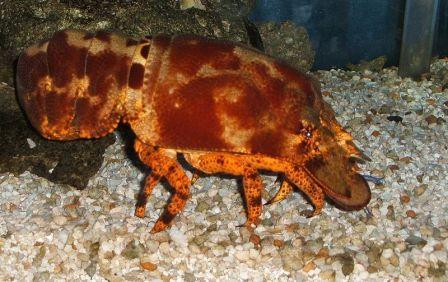
Photo credit: Steven G. Johnson
My obsession with the California spiny lobster has caused me to find all sorts of fascinating facts about lobsters. For starters, there are four main types of lobsters. According to the book Lobsters of the World by Austin B. Williams, there are the most famous clawed lobsters, the spiny or rock lobsters, the slipper lobsters and the squat lobsters.
Now I had never heard of the slipper lobster, but as you can see from the photo it is one crazy looking lobster. There are several species of slipper lobsters and they all belong to the scientific family Scyllaridae and live in various parts of the world. The slipper lobster in the photo is officially called Parribacus antarcticus and is commonly called the sculptured slipper lobster.
Sculptured slipper lobster females grow to be about seven inches in length and males can reach close to eight inches. Similar to the California spiny lobster, the sculptured slipper lobster spends its days hiding out in crevices in small groups and then roams the ocean floor at night. They have been caught as deep as 65 feet and according to the Marine Lobsters of the World website, these lobsters live in the western Atlantic, from Florida to northeast Brazil and in the Pacific Ocean near east Africa, Hawaii and Polynesia.
Supposedly the sculptured slipper lobster makes great eating and is fished by locals, but it’s too small for commercial fishermen to bother with. Hopefully that means the sculptured slipper lobster is doing well, but I couldn’t find any information on its conservation status.
Thanks for introducing me to the slipper lobster! I’m not sure I’d want to eat one though.
Your information about the sculptured slipperfish, that picture, and the california spiny lobster is completely wrong.
Hi Kyle, Thanks for your feedback. I double checked all the information in this post. The photo was taken at the National Zoo in Washington D.C., so I have to believe that the photographer read the displays correctly and I trust the National Zoo to know what animals they have on display. I also reread the information on slipper lobsters in the book: Lobsters of the World – An Illustrated Guide by Austin B. Williams. The information in my post is from this book and while slightly outdated since the book was published in 1988, the length for the sculptured slipper lobster should still be accurate.
I couldn’t find any information on the internet about a sculptured slipperfish and it’s not listed in Wikipedia’s list of fish: http://en.wikipedia.org/wiki/List_of_fish_common_names. And since the animal in the photo has legs and a hard exoskeleton, these features indicate it’s a lobster.